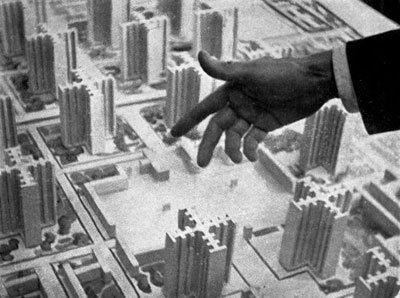
Structuring the World through Architecture & Administration
Architecture has been described as “a social art” and “an artful science” as it can affect moods, outcomes, thoughts, and sensibilities while performing its function. Architecture as a discipline is not just about designing and building beautiful structures – its value is enhanced due to the role it plays in organizing and shaping society. Architecture is inherently meant to provide a better human experience. Taking this very essence of architecture and integrating it with another discipline will make an architect, a very strong professional, capable of giving much more to society.
These ideas, thoughts, and expressions of an architect can be channelized in other fields such as Public Administration. The balanced use of artistic sense, wholistic views and scientific backing makes an architect a perfect fit for such roles. Architects must get a say, in a world where politicians and bureaucrats dictate the rules of how and where and how the development around us should be. It is essential that architects participate in crucial changes affecting the lives of our society and not simply being a backdrop to these decisions.
There are a lot of ways in which architects can shape the surroundings – apart from working in an architectural firm, working for the central government on a district level as a bureaucrat is one of them. This would mean that architecture would influence administration rather than the other way round.
In India, various state level and central level government exams are held every year for the posts of public administrators at different levels. The Union Public Service Commission Civil Services Examination or the UPSC CSE is a central level exam held every year and youngsters of age 21 to 32 give this exam to become bureaucrats. They are appointed by the centre and allotted various cadres. Other similar state level exams are called State Public Service Commission Exams. This field is not very known to architects. It is usually not considered as an option, mainly due to the amount of time one has put in to become an architect (5 long, tiring, and exhausting years! Phew!). How can one possibly switch to an administrative field after so much effort? This would be the first thought that comes to mind. But I’m here to tell you why and how this is possible. First, let’s get to some facts and statistics –
A civil servant or administrator at the district level is responsible for all the decisions when it comes to big projects such as service lines, pipelines, metros, transport – roadways, railways, waterways, airports, new constructions, and new tenders, and even the smallest project decisions. Broadly, an Indian Administrative Services (IAS) officer is responsible for framing policies, advising the ministers on various issues, maintenance of law and order, revenue administration, general administration, and supervising the implementation of the schemes in the area under him or her. Along with these massive number of responsibilities come a lot of perks and benefits – these include residence, job security, transport (vehicle and chauffeurs), personal security, lifelong pension after retirement, study leaves of 2 years (for upskilling), subsidised bills and post-retirement appointments as consultants or in various commissions.
If we analyze some data from the government website (https://easy.nic.in/CL-eBook/), what we find is that – Out of the 6106 IAS officers appointed in India from 1970 to 2020, only 8 are graduates in Architecture! This gives us the following reasons why architects repel from choosing this career path –
- There are not many idols to look up to in bureaucracy who are architects.
- There is not much talk or disposal of information regarding this career option in architecture.
- A lot of online queries about preparing for the UPSC CSE after completing B.Arch. suggest strongly to not pursue Civil Services giving the reason, ‘you’ve put in 5 years in completing architecture, why would you want to switch to administration after slogging for so long.‘
However, I feel there are numerous reasons which make the architect apt for such roles and why an architect should be considering Civil Services as an option. Following are the points usually missed out by architects as they are into architecture as a profession and not civil services.
Architects possess a lot of qualities that are cut out for the role of an administrator –
- knowledge about diverse fields, about the environment and spatial organization,
- understanding of town planning,
- the power of persuasion,
- the unique ability to visualize (helping give better insights than other professionals),
- our way of presentation and public speaking,
- skill of negotiation with clients,
- leadership qualities (leading the project from start to end),
- the ability to handle a lot of stress, work under pressure and still managing to complete the projects at hand
These are qualities that come in handy when you’re a bureaucrat and are expected to deal with the issues faced by the area under your administration.
Working in an architectural firm doesn’t mean the epitome of creativity has been reached, but creativity is enriched when applied to other fields. An architect’s skill of implementing abstract concepts into the real world and the experience of human interaction make us a strong contender when it comes to an alternative way of thinking. Architects are taught to think both linearly and laterally – the linear thought process is step by step, and keeps us grounded to the basic function leading us to the required outcome. Whereas, lateral thought process takes the help of abstraction and analogies and helps us in linking the ideas across different fields to create something imaginative and out of the box. It helps us predict what may happen in the future and plan and design accordingly for the future evolution of our society.
The creative problem-solving methods that architects use while designing are a big plus when it comes to concerns of the community. Apart from these abilities, subjects that architects are taught in architectural school also have great applications in the administrative fields. Architecture and Administration are in many ways intertwined with each other. The understanding one gets about people, their interaction with the surrounding environment, and what makes people feel comfortable and uncomfortable are skills that contribute largely to effective administration. Let’s take a look at how numerous architecture related subjects can be of use here –
- Architectural Design – it changes our perspective. We develop a more insightful and humane approach towards problems and sensitive issues.
- Environmental and Contextual knowledge – Having proper information of materials, climate, and terrain of the region will help us in various endeavours such as sustainability, being vocal for local, environmental conservation, using clean and renewable energy for various processes, etc.
- Climatology – it has uses in other fields such as agriculture, planning, disaster management, etc. It would be helpful in planning and preparedness by administrators for these sectors.
- History of Art and Architecture – India is a culturally and heritage-rich nation – architectural knowledge of the same will help in framing better policies and schemes as administrators concerning the conservation, tourism of Indian heritage. It will act as an important facilitator for the development of the district.
- Building Services – knowledge of various services and connections will help in finding a solution quickly for providing basic amenities to the people of the community.
- Town Planning – helpful for proper planning of transport and connectivity of major sectors of the district under administration and its connectivity to other districts.
- Interior Design – will be helpful for better organization and designing of government office spaces for optimum efficiency of oneself and the supporting staff.
- Humanities – It helps us gain a perspective of the numerous social and cultural dimensions of society and the importance of preserving and respecting them. It will help us in working towards the betterment of society and focusing on the less fortunate strata.
- Architectural Bye-laws and Regulations – It gives us an understanding of the purpose of the regulations and laws. It also helps us in understanding how laws are to be implemented. This gives us a basic idea and some level of experience in providing solutions and developing schemes within the restrictive order of the system.
- Software and Technology – these help in quick and easy visualization of projects. The use of a variety of softwares also helps bureaucrats stay technologically proficient for various needs.
The knowledge and awareness of these subjects can be converted into other types of philanthropy. Making a strong and sustainable foundation in these subjects for a better humanitarian purpose is never a waste of time. Looking at the current status of fresh architecture graduates who are constantly struggling to find good jobs in architectural firms (given the fact that architects never retire – which would mean fewer jobs for inexperienced candidates), brings us to a quote that says, “There is always vacancy at the top!”
There are a lot of career options for architects, the only requirement is that of exploring and shaping the possibility of a new beginning with some level of upskilling and perseverance. The results will surely give a lot of respect and purpose to your being. Bureaucracy is an example of such a career path – where you’re impacting society on a very large scale and you’re also at the top. It’s always a risk, to move on the road less travelled, but with sheer determination and hard work, reaching the top will be definitely rewarding and mentally satisfying.
About the author: Richa Malhotra, is a young architect who reflects upon the world through her eyes and paints it with words! Currently she is an aspiring civil servant and a learner at heart. She can be reached at richam31@gmail.com .































